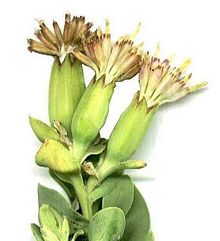
Back شيخاوية Arabic شيخاويه ARZ Senecioneae Azerbaijani Senecioneae Catalan Senecioneae German Senecioneae Spanish پیرگیاهتباران Persian Senecioneae Finnish Senecioneae French Senecioneae Croatian
| Senecioneae | |
|---|---|

| |
| Lopholaena coriifolia | |
| Scientific classification | |
| Kingdom: | Plantae |
| Clade: | Tracheophytes |
| Clade: | Angiosperms |
| Clade: | Eudicots |
| Clade: | Asterids |
| Order: | Asterales |
| Family: | Asteraceae |
| Subfamily: | Asteroideae |
| Tribe: | Senecioneae Cass. |
| Genera | |
|
See text | |
Senecioneae is the largest tribe of the Asteraceae, or the sunflower family, comprising over 150 genera and over 3,500 species.[1] Almost one-third of the species in this tribe are placed in the genus Senecio.[2] Its members exhibit probably the widest possible range of form to be found in the entire plant kingdom, and include annuals, minute creeping alpines, herbaceous and evergreen perennials, shrubs, climbers, succulents, trees, and semi-aquatic plants.[3]
Plants in this tribe are responsible for more livestock poisonings than all other plants combined.[4] Its members usually contain liver and kidney toxic and carcinogenic unsaturated pyrrolizidine alkaloids in Senecio[4] and furanoeremophilanes in Tetradymia.[3]
A number of species are well known in horticulture.[3]
- ^ Cite error: The named reference
cwgwas invoked but never defined (see the help page). - ^ Pelser, Pieter B; Nordenstam, Bertil; Kadereit, Joachim W.; Watson, Linda E. (November 2007). "An ITS phylogeny of tribe Senecioneae (Asteraceae) and a new delimitation of Senecio L.". Taxon. 56 (4). International Association for Plant Taxonomy (IAPT): 1077–14E(–1062). doi:10.2307/25065905. JSTOR 25065905.
- ^ a b c Barkley, T.M.; Brouillet, L.; Strother, J.L. (2006). "Senecioneae". In Flora of North America Editorial Committee (ed.). Flora of North America North of Mexico (FNA). Vol. 20. New York and Oxford: Oxford University Press. Retrieved 2008-04-14 – via eFloras.org, Missouri Botanical Garden, St. Louis, MO & Harvard University Herbaria, Cambridge, MA.
- ^ a b Pieter B. Pelser, Barbara Gravendeel and Ruud van der Meijden (2002). "Tackling speciose genera: species composition and phylogenetic position of Senecio sect. Jacobaea (Asteraceae) based onplastid and nrDNA sequences". American Journal of Botany. 89 (6): 929–939. doi:10.3732/ajb.89.6.929. PMID 21665692.
© MMXXIII Rich X Search. We shall prevail. All rights reserved. Rich X Search